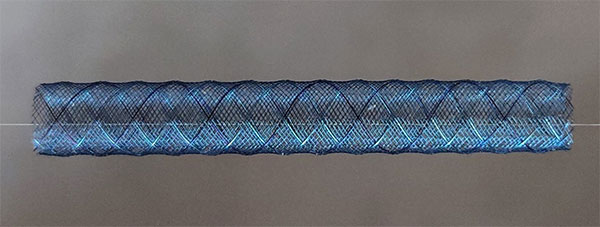The research team of Sree Chitra Thirunal Institute of Medical Science and Technology (SCTIMST), has developed an innovative intracranial flow diverter stent for the treatment of aneurysms (enlargement of an artery caused by weakness in the arterial wall) of the blood vessels of the brain. It is ready for transfer and further testing in animals, followed by human trials.
Flow diverters stents when deployed in the artery in the brain bearing the aneurysms, divert blood flow away from the aneurysm, thus reducing the chances of its rupture from the pressure of blood flow.
The flow diverter developed by SCTIMST, an Institute of National Importance under the Department of Science and Technology, is designed to have a better grip on the walls of arteries of complex shapes in order to reduce the risk of migration of the device.
Intracranial aneurysm is a localized ballooning, bulging, or dilation of arteries in the brain caused by progressive weakening of the inner muscles of the wall of the blood vessels.
Spontaneous rupture of the aneurysm can result in bleeding into the space around the brain; a resulting condition called a subarachnoid hemorrhage (SAH). Subarachnoid hemorrhage can lead to paralysis, coma, or death.
The Surgical treatment of an aneurysm involves opening the skull and a clip on the neck of aneurysm so that it is cut off from the path of blood flow.
There are three nonsurgical, minimally invasive endovascular treatments of aneurysms of the brain. In two of these procedures, the aneurismal sacis filled with platinum coils or occluded using high viscosity liquid polymer, which solidifies when released into the sac, thus sealing the sac. All these techniques have some limitations or the other.
A more attractive third minimally invasive option is deploying a flow diverter stent to bypass the segment of the blood vessel, which has the aneurysm. Flow diverters have the advantages of being flexible and adaptable to the shape and course of the vessel. Also, flow diverters promote healing of the vessel wall by removing the constant stress of blood flow on it.
Besides being designed to have better grip on the walls of arteries of complex shapes in order to reduce the risk of migration of the device, the unique design in the weave of The Chitra flow diverter, also makes this stent resistant to kinking or twisting, when it is placed in tortuous arteries and those with complex shapes. Even a 180 degrees bend does not occlude the lumen of the stent. Portion of the wires is made radio-opaque for better visibility in X –Rays and fluoroscopy, thus aiding accurate delivery of the diverter in the blood vessel.
Nitinol, a superelastic alloy with shape memory, was acquired from National Aero Space Laboratories, Bengaluru (CSIR-NAL). When the device is deployed at the site, it is released from its crimped locked position and assumes the desired and originally designed shape because of the shape memory property of Nitinol. The flow diverter is delivered to the aneurysm in the brain using a delivery system. The delivery system has also been developed by the team.
The imported flow diverter stents cost Rs 7-8 lakhs and are not manufactured in India. With the availability of the indigenous technology from SCTIMST and Nitinol from NAL, a well-established industry should be able to manufacture and sell at a much lower price. The device is expected to be transferred to the Industry very soon and will subsequently undergo testing in animal and human clinical trials before commercialization.
SCTIMST has filed separate patents for the stent and the delivery system. The team was led by Dr. Sujesh Sreedharan, Mr. Muraleedharan CV, Mr. Ramesh Babu(Biomedical Technology Wing, SCTIMST)Dr. Jayadevan ER, Dr. Santhosh Kumar K.(Department of Imaging Sciences and Interventional Radiology, Hospital Wing, SCTIMST) Mr. Rajeev A, Mr. Subhash Kumar MS, Mr. Anku Sreekumar, Ms. Jnana N. J, Mr. Sree Hari U, Ms. Liji G.V.































